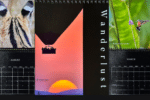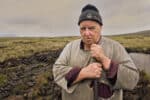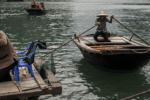Just like the opener, you never know exactly where it’s going to come from.
Our efforts to document UAV stuff led us to an abandoned warehouse in Boston, where a drone called Skate was undergoing tests and observation. Built as an ultralight weight alternative to bigger drones such as Raven, the Skate basically comes in a box, and a child could most likely put it together. It’s a bunch of styrofoam like material with propellers and a camera, and when you start the props, it just leaps out of your hands.
Well, trying to photograph this flying piece of foam was harder than catching a fart in a bag. The thing would generally head in the direction its controller headed it, but honestly, its flight pattern reminded me more of dropping a baseball card from the top of a building. It would waft, wiggle, flutter and float. I went chasing this sumbitch around a warehouse with a camera in my hands and a flash on a pole, until I realized how utterly ridiculous that was. See below for a truly memorable frame.
Holy shit. I was in big trouble, and I knew it. The warehouse was spectacular, and the Skate was essential to the coverage, and I walked in there feeling confident. After its first couple of flights, though, my heart plummeted, until I realized that the one singular thing about this drone was that you could catch it by hand. The bigger military drones had to crash land on the ground and get picked up in pieces and reassembled. This puppy would fly, roughly, into someone’s paws. It was the one way I could show difference in this unit, as opposed to the others, which was good information for the reader. And, it was one way I could get the thing to fly into my camera, instead of having me chase it like a lunatic with a D4.
I had no idea it would be the closing image. None. Decisions like this are made above my pay grade. I was happy enough with this result, to be sure, and I urged Bill Douthitt, my editor, to put it forward. For me, it signaled just a bit of difference. The hands humanized the scene, and made it a bit odder than the rest of the coverage, which de facto was a bunch of pictures of machines flying over something or other. Bill, in this rare instance, went along with the notion. Generally, he simply listens to my fevered reasoning, smartly advises me to stay out of it, and tells me my best resort, if I’m going to be that emotionally wrapped up in my work, is to find the nearest bar. I hate to admit this publicly, but he’s a brilliant editor, and he’s almost always right. Which is why I generally refer to him as the Dark Lord of photography. When I go on assignment, I call, and in my best Orc-like voice, I simply ask, “What does the great eye command, sire?”
Below is a production shot of the approach.
After seeing these, Bill offered the wry commentary about me generally doing my best work when I don’t look through the camera. Which in fact I didn’t on this shot. Nor did I use live view, as handy and obvious as that would seem to many. I generally know the feel and field of the 24-70 I had on the camera at the time, and, sort of going back to my rangefinder camera days, I prefer to have both my eyes outside the camera, judging the approach and size of this vehicle as it approached my airspace. I would just click when if felt right.
Below is a grid of info submitted to Geographic with the raw file.
Of course the controller is not seen in this frame, being hidden by the outstretched hands. And of course, I went to the trouble of lighting the controller. Sigh….
More tk….



















I really like the image, yet before reading the text I thought the drone was just leaving the hands.
Nope, you can tell by the attitude of the bird it’s incoming….Joe
I bet those little propellers would feel just wonderful whacking your pinky finger!
Dear Mr McNally,
Youd think that at a 30th of a second you would get a decent propellor blur.
You only have to shoot helicopters at a 250th once outdoors never to do that again. There are three options in your shot. (1) Use hot lights to augment natural light (2) Bump up ISO and possibly ditch the flash altogether (that pole looks very dangerous and must make the boom operator v tired or (3) simply drop shutter speed til the props do blur. As you were shooting for National Geographic you could not put the spin and blur in Photoshop. But subject blur would have brought the plane alive. It looks pasted in as is. Before this sounds like a criticism you’ve made so many good shots in the past that you are allowed a less than stellar image and you will learn from it. Regards JY
tough shoot joe, square sleek panel in a rough warehouse, dont know how I would have approached it, I support jan in that it does look like something dropped down a lift shaft. But, but before you throw a hissy fit, it made me lean into the photo. Leaning into a photo is a good sign and I looked at it. Looked at it some more and learnt loads.
Sometimes the ones that look wrong are just right for the words, tough shoot. I had a hell of a shoot the other day, and the shot I hate the most was splashed all over the papers and net. Bad day out of the office is better than a good day in. Heard that somewhere.
Rich
Love the photograph and the sorry, Joe.
But I agree with Jan. Until reading about it, I hate assumed the thing was flying off, not coming in for landing. Is something about the hands.
Goes to show I should have been more observant.
“What does the great eye command, sire?” That’s awesome. And here, I thought you were the master! 😉
Absolutely love your work, Mr. McNally. I’ve learned such a great deal from you over the years…thank you. -Scott B.
Yes, the propellers are toward the retriever, but when I, too, saw the picture (in the mag) I thought it was being launched. You just assume it… One doesn’t know if there is another set of props on the other side, and one doesn’t assume that a drone is caught upon return. I really like the photo as printed — I like the blur of the warehouse windows and the drone itself… why the heck Mr Yeats is telling you how to git ‘er done is beyond me… the last thing this needs is propeller blur… I’m happy though that he has clarified for you and Nat Geo how to make a proper photo! We can thus look forward to a more professional publication in the future. 😀
REALLY digging these NatGeo behind the scenes posts… good stuff! Thanks for sharing!
Is that near the old Quincy Shipyard? What’s left of it.
Suprised you didn’t do a Gjon Mili stroboscopic on the hummingbird Joe. I could totally see you pulling that off and making it look fascinating. Great work showing up the process behind the result!
Really enjoyed the NG story, and am enjoying the behind the scenes stuff even more so. I particularly liked the nano hummingbird image – the shadows cast by the fans in the background look great – strategically placed & gelled small flash I’m guessing?
Good stuff. I always learn something from your BTS commentary. From a learning perspective, I think the prop blur is interesting. Joe – all comments aside, how would you have done the blur, if desired, in this shot?
Awesome post. As captain obvious has pointed out above…a 30th of a second would provide good motion blur of a spinning prop (thanks tips!). May I add that his is only true IF something is moving. I imagine from observing this image that the incredibly light weight drones’ prop stops spinning as the handler catches it saving his fingers from an untimely extraction. Were the drone leaving the handler I would expect to see motion blur from the props. Thanks for the great options JY for shooting “helicopters” on location in abandoned warehouses. We’re all en”light”ened.
oh, i forgot to add:
MANY THANKS for taking the time and making the effort to share, very valuable… you’re a gem, kiddo :-)))))))))
Very cool perspective on this shot! Can’t believe you framed this so well without your mug behind the camera, true skill! This shot sorta reminds me of a wide receiver reaching out for the glory. 😉
Another facinating “behind the scenes”, Joe. These posts are so interesting and inspiring to hear how even the best in the biz gets flummoxed at times. Cool shot!
Hi Joe!
I can perfectly imagine you moving like a drunk guy when chasing the drone at first and then changing completely the approach for getting the shot.
Excellent photo, it really describes what that thing is and the blurred background totally gives the sensation of movement. I must admit that I also thought that the drone was being launched rather than received!
Regards from MX!
Joe,
Enjoyed your back story as much as the published images in NG, especially the dragonflyer from the highway at dusk…well done!
Thanks,
Bob
As always, another inspiring story Joe. Great photography and great writing. The BTS commentary is always of interest. Perhaps the best part your sense of humor. Thanks for the blog!
Thanks, Joe, for going through these for us – the BTS descriptions/photos are priceless.
So interesting to learn what folks pick up on . . . frozen props? I doubt the props are ‘frozen’ because the unit’s been shut off as was suggested or we’d see a bit of blur there just as we do in very nearby areas. Doesn’t it make sense that the props are frozen (something that doesn’t bother me given that Joe’s camera movement a la slow ss & shooting from the hip is providing the ‘motion’ feeling kind of all over) because at 1/30, even w/ a ton of ambient light, you’d never see them because they’re spinning so dang fast? Just take a look at the other ambient-mostly images from the story – see any propellers there? Given the exposure, they’re simply not even there to the camera w/o the pop from the SB, and cranking up the iso to get the 1/1000 you’d need to get the blur (helicopter blades after all travel WAY slower than these little guys) would of course eliminate the much more valuable camera shake.
Anyhow, please keep ’em comin’!
I think that the blur you see on the background speaks of movement as much as a foreground blur, but it lets you observe the detail of the photo’s subject (the UAV).
This technique is largely used in motor sport photography, see F1 pics, and no one ever complained about its ability to convey the sense of fast movement, as it’s seen here.
Me too I think the hands add to the readability of the pic and put in evidence the proportions at play.
Great to know this BTS, thanks for sharing with us, the passionates.
Hey Joe, thanks for your reply. I guess with knowing zip about drone behaviour I defaulted to reading direction as a clue when making my conclusion.
I really liked the whole series and enjoyed reading about drones other than the armed military ones. And as Joe Ethridge said: thanks for the BTS stories, one learns so much! Best,
Jan
Tim Tilden nailed it. The former “pipe shop” at Fore River Shipyard. Not actually a “warehouse” originally, but a fab shop for the shipyard.
Apart from being educating – the writing of this piece is simply brilliant. Inspirational stuff Joe. ~H.
As always, thanks for taking us along on the shoot. Great to see the behind the scenes stop. Makes my shoots look less hectic!
All the best.
John
Wish your production assistant had not used that fisheye lens on the third picture. Makes my butt look big. 🙂
Dear McNally, I’m a SouthKorean loved your pictures…
But today, I want to said to you a bad news…
Do you know your photo used twice by KBS & SBS, the South Korea’s broadcasting companys? They used twice your photo that pictured ballerina Paloma Herrera’s foot to lies…
They says twice….
This is a lies correctly, Korean peoples are very angered,
so this is very big issue in SouthKorea now…
Many peoples in SouthKorea hope you had to say the truth,
and never fogive the broadcasting companys’ lies…
I’m very, very sorry about to tell you this bad news…
They says twice, This is a foot of Son Yeon Jae, a Korean athlete of rhythmic exercises….
http://sports.donga.com/3/all/20130309/53569901/2
This is a link about the bad news
Hi, joe mcnally. I’m a citizen in korea. Yesterday, I got to know that your photo about ballerina’s foot was used in the T.V program “Thank You” of SBS ,the Broadcasting company in South korea. so I’d like to inform you of this. By the way, the foot in the photo was introduced as Son yeon jae’s foot(she is a korean gymnast) and the photo was not explained as your photo. I’d like to know if you allowed them to use your photo in the T.V program and to use the photo as another girl’s foot.
For Jerome Yeats, Dave Benard and Steve Hambuchen, I don’t know if the propellers were turning but I have shot flying airplanes and helicopters. On many planes 1/250th will provide about 10 degrees of propeller blur, 1/1000 will just about freeze most propellers. If you wanted the whole circle, you could figure out the fastest shutter speed from the number of propeller blades and RPM. Shooting indoors, in a dark area and using speedlights, shutter speed is not very relevant for items lit by the speedlight because the flash duration is about 1/1000th, and that is what freezes motion. The background blurs because it is lit by ambient light, and responds to the shutter speed.
cameraclicker, I can confirm that the propellers were, indeed, turning during that shot. I will also say that our team had a blast working with Joe and his folks on this shoot.
Dear Mr McNally,
It’s amazing how people will pop up to defend you if they think you are being criticized. I meant that in the past I shot a helicopter in the Alps at a 250th and this was enough to “stop” the rotors completely – unfortunately. It all depends of course how fast the rotors were moving in the first place. I am about as old as you are and I think we both know that you can’t impart wisdom or common sense to those whose ideas are rigid. My point is that still propellors look like cutouts and not part of powered flying machines. You will know too that we have both shot for world class publications and agencies. Though I have never worked for National Geographic but here’s the deal: you have shot wonderful images and will do so again but this one was not one of your better ones. Thank you for posting my comment. It had no malicious aim. You know that there were alternative ways of shooting this image. I merely pointed out what would have worked better IMO. Sheesh. Regards JY